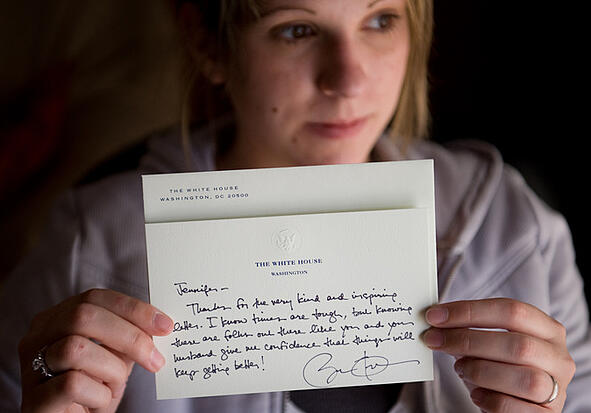In light of the most morally interesting Presidential race in recent memory, we think it’s fair to say that the candidates use of direct mail is one of the few consistencies in comparison to prior elections. Tried-and-true, unmistakably American and known for delivering on its promise of ROI, we'll take a moment to review how the candidates are utilizing the channel to drum up support and influence voters who are on the fence.
Political direct mail
As we continue to pave the way for highly variable, data-driven direct mail, we often overlook DM's original function: basic communication. No product or service. No hyper-segmented strategy with award-winning creative—just good old-fashioned, one-to-one, contact. From the long lost pen pal to the loved one living across the country, direct mail has always been rooted in a more personal form of communication.
And while it was supremely important back then out of necessity, it especially holds true in the political arena—when dealing in matters of socioeconomic input, the intimate nature of casting a vote and having your views represented by a candidate/party will always be an emotional decision (for better or for worse).
Simply put, direct mail is the channel that best represents this nature of exchange and it is currently the largest primary driver for political correspondence and contributions. In fact, a candidate's fundraising (and outreach) efforts are often one of the deciding factors in determining the viability of the candidate themselves.
2008 & 2012
No political direct mail campaigns (or strategic marketing initiatives, for that matter) garnered the same kind of attention as the last two presidential elections. In 2008 and 2012, we saw multichannel marketing dominate the political arena. President Obama, in particular, did a tremendous job at harnessing the raw power of the digital landscape, capitalizing on his website, the blogosphere and social media. So much, in fact, his 2008 campaign (Obama for America) managed to secure two prestigious Cannes Lions awards.
And his direct mail? Well, the message and positioning was consistent and rooted in his approach—clean, direct and showered with a similar type of language. Also, take note of Obama's team making full use of OE messaging and imaging. All political views aside, we can't argue that this is a gorgeous piece of DM.
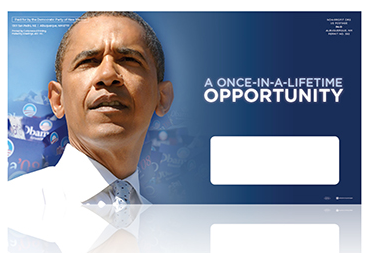
And after all the mailing lists were segmented and political contributions secured, Obama added a personal touch to his mail initiatives—the hand-written correspondence (see below).
But just as direct mail is used to engage and compel, it can also be used to assail and belittle. Here, we see political direct mail being used to attack President Obama's initiative to elect a Chief Justice to Alabama's Supreme Court, using a Godfather-esque theme and playing to everyone's admiration for Francis Ford Coppola's work.
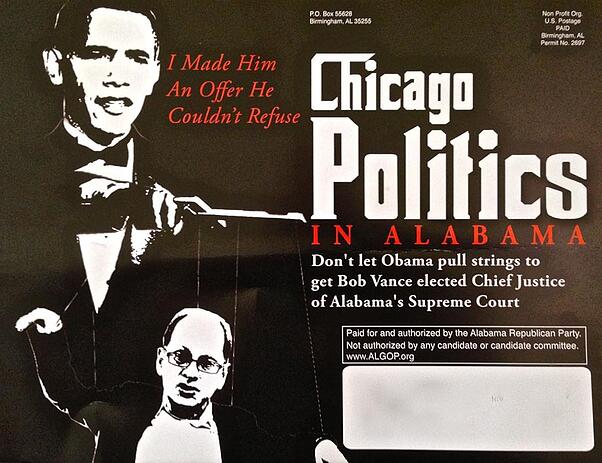
In another example, we see an attack mailer calling out Obama's time as a Senator and his stance on the Born-Alive Infants Protection Act. Important to note: we see this piece of DM using traditionally digital tactics, i.e. the clickbait, scare-tactic in order to drive response rates.
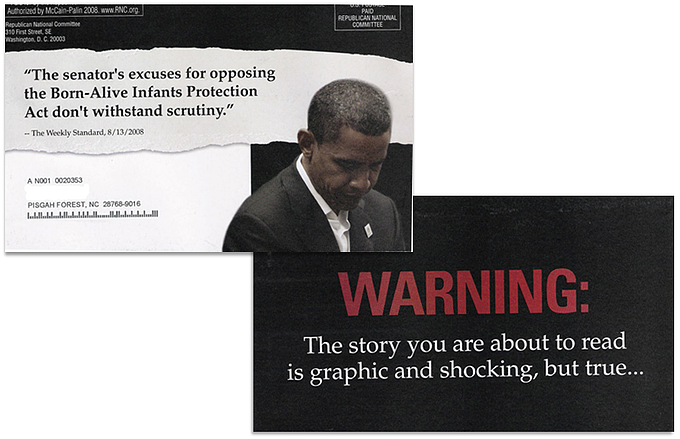
2016 onward
Although the multichannel approach has certainly become the baseline for engaging voters (and customers alike), direct mail is still the main driver of response. And it makes sense.
From its physical nature to its historical significance, DM remains one of the most intimate and personal marketing channels. When asking for support (in the form of a vote or donation) that might have serious implications on your present and future socioeconomic health...well, it's a no-brainer why DM is still the preferred communication method.
In the case of Dr. Ben Carson, his campaign for the Republican Presidential nomination has been a standout case use of direct mail, completely assailing the long-held view that access to big donors is the only way to secure funding and support. Until the very end of 2015, Carson's campaign fundraising efforts had exceeded all other Republican political campaigns in individual contributions (over $1M in individual contributions with an average donation of $50).
This windfall success can be directly attributed to Carson's strategic use of direct mail—the same media channel that enhances branding, communicates candidate sentiments, and drives voter turnout that helped to secure over $50M in individual contributions.
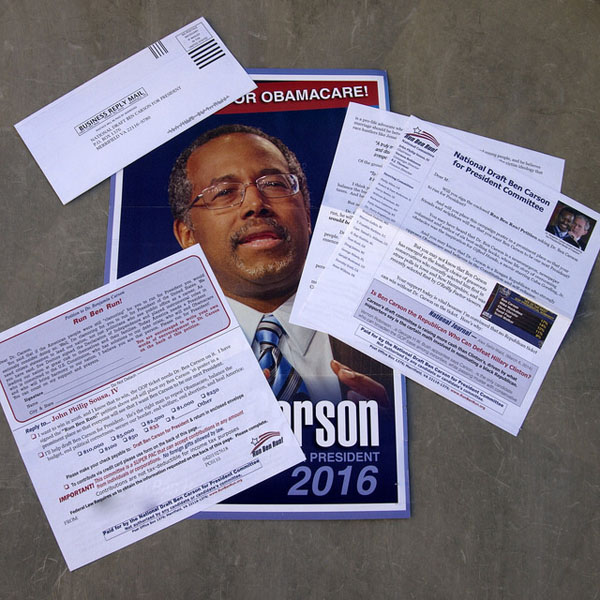
The Carson campaign leveraged direct mail through sending targeted mailers and allowing potential supporters to take a deeper dive into his background and political stance. The good doctor even took this one-step further by including a borderline-creepy portrait into one of his DM campaigns—that's one way of making it more personal.
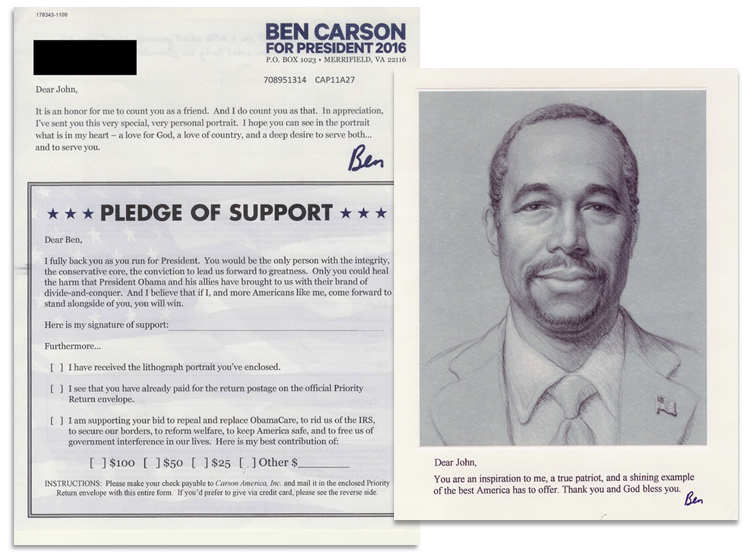
And while Ben Carson's now-defunct Presidential campaign faces collusion allegations, Ted Cruz chose to push direct mail to the darkside—using predatory and shaming tactics to drive voter engagement. His mailer, seen below, incorporates an intentionally misleading message and has all the tell-tale signs of manipulative mail. From the manila envelope and the choice of language down to the translucent yellow paper traditionally reserved for violations, this direct mail insinuates the recipient has not voted in recent years and the solution is a vote for Ted Cruz.
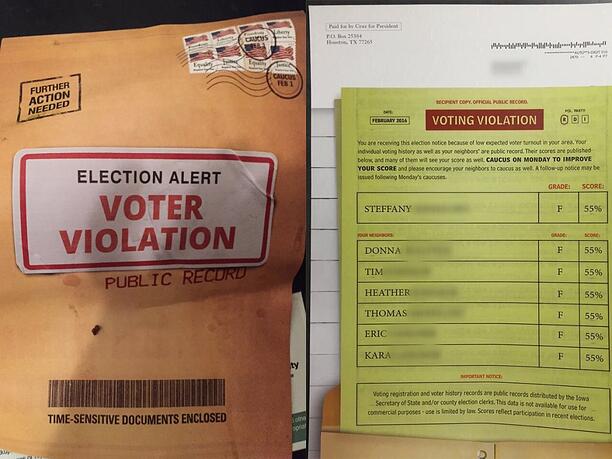
For his next act, Cruz created a match-type fundraising mailer that increased both open rates and suspicions. In this example, the direct mail is in the form of a letter with a tear-off check affixed—even the OE contains a snipe that reads "Check enclosed." What the mailer fails to mention is that the check enclosed is actually from Cruz to himself—any donation you give Cruz will be matched by an anonymous support group.
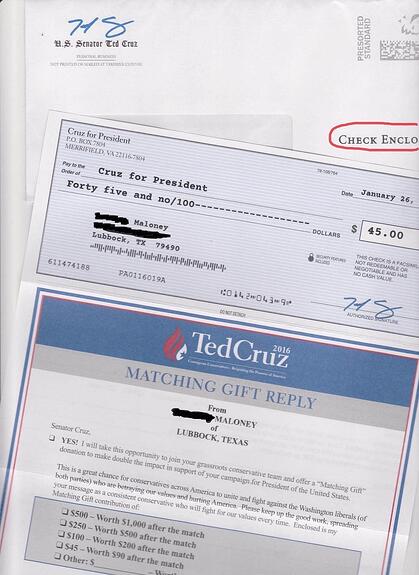
Strip away possible legal ramifications and misrepresentations, you have to admit the creative element at play is something to marvel at. Sure, Ted Cruz stooped to the lowest of the low and contributed to the "direct mail is junk conversation." But, we can't help but imagine open rates were through the roof...response rates not so much.
Key takeaways
Although recent developments have painted DM in a certain light, candidates (and marketers) can still benefit immensely from understanding best practices when dealing in political direct mail. They are:
- Honesty's the best policy: Especially in the political arena, being honest is key to driving engagement and earning support. Don't mislead or misrepresent the facts and certainly don't employ misleading mail tactics. Your open rates and PR might increase momentarily, but your overall brand will suffer.
- Make it relevant: Keep in mind the nature of the offer and create messaging that speaks to the segment's particular pain point. One famous example (see below): Mitt Romney created an entire direct mail campaign around his stance on Lyme Disease—not the biggest talking point, but highly relevant to his target audience.
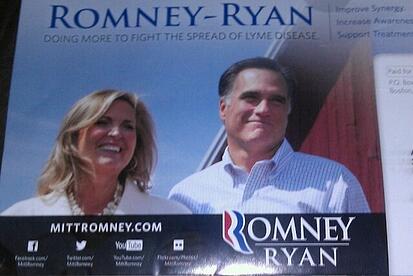
- Go big or go home: When it comes to format choices, go with the 8.5” x 11” mailer over the 5.5” x 11." This increased real estate will be sure to stand out in the mailbox and provide more real estate for relevant messaging and creative.
- Brain segmenting: It's a well-known fact that compelling creative drives engagement, but be sure that your creative choices play on a voter's more primal, reptilian brain. Because the nature of this offer is highly emotional, using creative that plays on basic human tenets, i.e. appealing to innate selfishness or showing contrasting elements (in this case, the candidates), will ensure you are messaging directly to the decision maker.
- Align online & offline measures: A multichannel marketing approach is only as strong as its cohesiveness. Ensuring that all marketing material, i.e. landing pages, banner ads, and direct mail have the same theme/congruent messaging, will be a surefire way to drive both votes and contributions.

